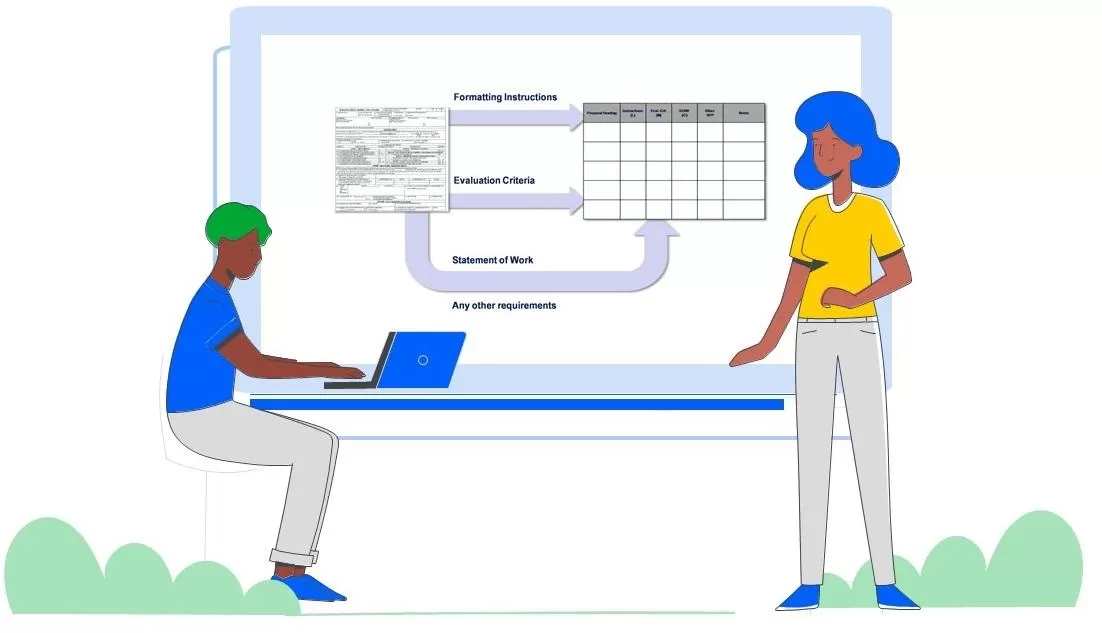How to create a great proposal compliance matrix
Why creating a proposal compliance matrix is so important.
The process detailed below for creating a proposal compliance matrix, shows writers where in the proposal they should address every RFP requirement:
- Definition: A proposal compliance matrix uses a grid to show which RFP requirements are relevant to each section of the proposal.
- A proposal compliance matrix shows proposal writers where the customer expects to find each require addressed in the proposal.
- A proposal compliance matrix shows exactly which RFP requirements are part of each proposal writing assignment.
- A compliance matrix increases win probability by helping you create a proposal outline that puts everything where the customer expects to find it.
- While an RFP Compliance Matrix is not the only thing you need to know what to write in your proposal, it is usually the starting point.
- The first step in building a Proposal Content Plan is to create a compliance matrix.
The proposal Compliance Matrix was developed to respond to RFPs with hundreds or even thousands of requirements to be addressed. Multiple overlapping sections of the RFP may have requirements affecting various sections of the proposal. An RFP Compliance Matrix shows all of the requirements that are relevant to each proposal section. They help proposal writers untangle the mess of requirements that many RFPs are and figure out where in the proposal to address each of them.
For very simple proposals a Compliance Matrix may not be necessary. If all sections of the RFP are already perfectly aligned, then the Compliance Matrix may not be needed. However, if all section of the RFP are not in perfect alignment, then a Compliance Matrix is vital for understanding how they map to the proposal outline, ensuring compliance with all of the requirements, and making sure that everything in your proposal is where the customer expects to find it.
A Compliance Matrix is often required for proposals written in response to Federal Government RFPs. A Federal Government RFP will typically have separate sections for the outline/formatting instructions (“Section L”), evaluation criteria (“Section M”), and statement of work (“Section C”). Creating the proposal outline requires cross-referencing. To create the outline, you start with Section L, which tells you the high-level outline. Next you incorporate Section M so that your outline reflects the Evaluation Criteria. Then you incorporate Section C to round out the outline with what you need to be compliant with the RFP. You may also need to include other sections of the RFP if they contain requirements that must be addressed in the proposal. If Sections L, M, and C are not in perfect alignment, then you may need to cross-reference the various sections of the RFP in order to complete your outline.
For other (Non Federal Government) RFPs, you should look for RFP sections that correspond to formatting instructions, evaluation criteria, and a statement of work and then follow the same general approach. The more sections that an RFP has and the more they overlap, the more critical it becomes to have a great compliance matrix.
Even if the customer hasn’t issued a written RFP, a cross-reference can be built by formally identifying the customer’s requirements and turning them into a list.
Whenever the RFP is complex and you create a compliance matrix, you should consider submitting a copy with the proposal to help the evaluators see that you are compliant.
The steps for creating a great proposal Compliance Matrix are:
Return to: Starting a Proposal Based on an RFP, or return to the Starting Point: Figuring Out What to Say in Your Proposals.
Access to premium content items is limited to PropLIBRARY Subscribers
A subscription to PropLIBRARY unlocks hundreds of premium content items including recipes, forms, checklists, and more to make it easy to turn our recommendations into winning proposals. Subscribers can also use MustWin Now, our online proposal content planning tool.
Carl Dickson
Carl is the Founder and President of CapturePlanning.com and PropLIBRARY
Carl is an expert at winning in writing, with more than 30 year's experience. He's written multiple books and published over a thousand articles that have helped millions of people develop business and write better proposals. Carl is also a frequent speaker, trainer, and consultant and can be reached at carl.dickson@captureplanning.com. To find out more about him, you can also connect with Carl on LinkedIn.



